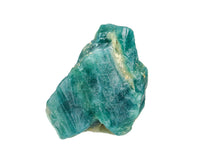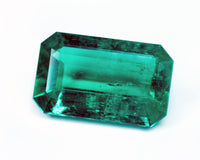- 1. Moonstone
- 2. Moonstone History
- 3. Moonstone Properties
- 4. Moonstone Types
- 4-1. Adularia moonstone
- 4-2. Rainbow moonstone
- 4-3. Belomorite moonstone
- 4-4. Labradorite (black moonstone)
- 5. Moonstone Value
- 6. Moonstone Healing Properties
- 7. Moonstone Magic Properties
- 8. Moonstone for Sale
Moonstone
Moonstone is an incredibly beautiful mineral that keeps in awe with its extensive range of colors and magnetizing radiance. The gem got its name because it looks like a miniature version of the moon. Legends say that the Earth’s satellite nurtures rocks and fills them with its shine until they turn into gorgeous gems. Whether you believe in legends of scientific facts, you can’t deny the pulling power of this mineral.
Moonstone History
Despite their name, moonstone isn't found on the Moon. These foggy crystals that emit a pale light were first discovered in the alpine Adula Mountains. This place is reflected in the scientific name of the mineral, adularia. Moonstone is a trading name of a few types of minerals offering a similar look and properties.
Even the official name of the stone is not entirely correct. Adularia is colorless orthoclase (a variety of feldspar) while moonstones consist of both orthoclase and albite. At the same time, the ability of the gem to display a scintillating bluish glow under illumination is called adularescence.
Moonstone Properties
Moonstone is the collective name for a family of minerals called iridescent feldspars. The thing all these gems have in common is adularescence. In bright light, well-polished minerals become shimmery and even pearlescent. In other words, moonstones’ look gets akin to blue-white pearls.
By chemical composition, iridescent feldspars are divided into two groups:
• potassium spars (microcline, orthoclase, sanidine);
• calcium feldspars (andesine, labradorite, plagioclase, oligoclase, albite).
Besides a dissimilar chemical composition, these stones differ in their internal structure, the presence or lack of microcracks, air inclusions, as well as intergrowths of layers into each other.
According to the Mohs scale, moonstone’s hardness is 6.0-6.5. Despite this, it is a rather brittle mineral and it requires careful maintenance. You should keep it away from high and low temperatures and chemicals. Try to avoid impacts because your moonstone may fracture.
Moonstone Types
Adularia moonstone
Adularia is a quite rare and therefore very valuable gem. Unlike other moonstones, it doesn’t have microcracks in its internal structure. High-quality gems are mined in Tanzania, Sri Lanka, India, etc. The gemstone is known for strong blue opalescence (adularescence) although it can’t boast flashes of multiple colors. When being cut en cabochon, many specimens exhibit a single-beam asterism (cat's eye effect). Adularia is the only variety of moonstones that provides amazing three-dimensional depth. The most valuable adularias bear the trading name royal blue moonstone.
Rainbow moonstone
Rainbow moonstone is plagioclase or white labradorite. Raw crystals are almost opaque, white in color, and with a pearlescent tint at the fractures. When cut en cabochon, they lose asterism but instead, they acquire translucency and iridescence that resembles gasoline stains on the surface of the water. Simultaneously with the blue glow, it displays yellow, pink, and purple hues.
Belomorite moonstone
Belomorite moonstone is a variety of oligoclase. It was named after the White Sea (Beloe More in Russian), on the shores of which it was found. In contrast to adularia, belomorite is iridescent. Its glow is multicolored and dominated by small flashes of blue-green and red. You need to be very careful when choosing belomorite since many specimens have visible cracks.
Labradorite (black moonstone)
Labradorite, otherwise known as black moonstone, boasts an iridescent blue-green and purple sheen. People often compare it with peacock feathers due to the similarity of colors and shimmering.

Moonstone Value
Color, transparency, optical effects, and size are the main factors that affect the value of moonstone. The most expensive ones are specimens delivering blue hues and extraordinary three-dimensional opalescence. Such moonstones are very popular with collectors.
Some of the cheapest moonstones are mined in India. The price of a 1-carat stone fluctuates within the $1–30 range. Large and beautiful specimens may cost more than $ 80 per carat.
Moonstone Healing Properties
Moonstones are highly valued for their ability to ‘suck’ negative energy out of their owners. They are capable of stabilizing the energy field of a person and enhancing the flow of positive vibrations. In addition, moonstones can heal minor skin damage: scratches, burns, bumps, etc. Folk healers endow the gem with the power to treat epilepsy – they claim that it weakens and shortens epilepsy attacks.
Lithotherapists believe that moonstones are able to facilitate childbirth and improve the operation of the pelvic organs. On top of that, they say that the gem can control emotions. It is especially handy if you intend to curb outbursts of aggression and fear. You can also use moonstone to get rid of insomnia and promote the functioning of the digestive tract. If you regularly wear moonstone jewelry or talismans, you can take advantage of the stone’s ability to improve the movement of fluids in the body. This peculiarity is especially valuable if you want to remove kidney stones or slow down the growth of tumors.
Moonstone for jewelry making for sale
Moonstone Magic Properties
The rarest variety of moonstone provides a yellowish color. According to legends, witches use yellow moonstones to absorb their powers and deceive death. If you’re an owner of a yellow adularia, you should carefully scrutinize it. Stones that contain witch powers acquire a yellowish-red or even bloody hue during a full moon. Even if you don’t have one of these magical stones, it is not uncommon for moonstones to become cold on full moon nights. It is believed that such stones are most suitable for magic rituals.
If you don’t practice magic, the gem is beneficial to enhance your intuition. Apart from that, the stone is a peacemaker. If both spouses have moonstone amulets or accessories, they will never have fights or misunderstandings.
You need to be careful with moonstones, especially during the waning of the Moon. It is believed that weakened gems may turn into vampires and feed on their owners’ vital energy. For this reason, you need to hide moonstone items when the moon shrinks.
Moonstone for Sale
Looking for enchanting royal blue moonstone? Or maybe you enjoy the pallor of white moonstones? Do you want to get a multi-colored gem? Then KenKenGems has got you covered. We offer a great variety of charming moonstones in the range of white, gray, pink, brown, blue, and other natural colors. If you wish to make the most of moonstone’s natural beauty and designer colors, we have coated gems displaying vibrant hue transitions. Strands, half strands, moonstones set in silver, loose stones – all of this is and more awaits you in KenKenGems catalogs.










